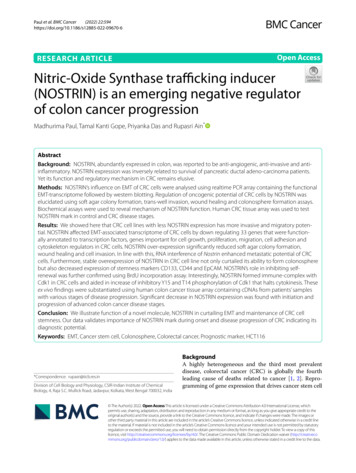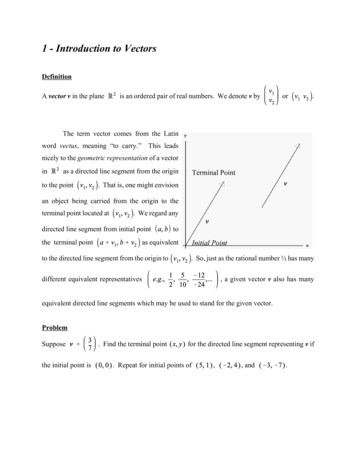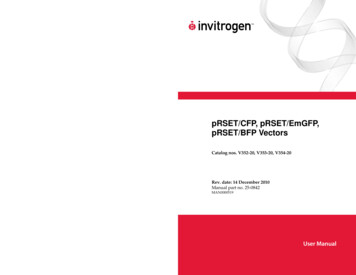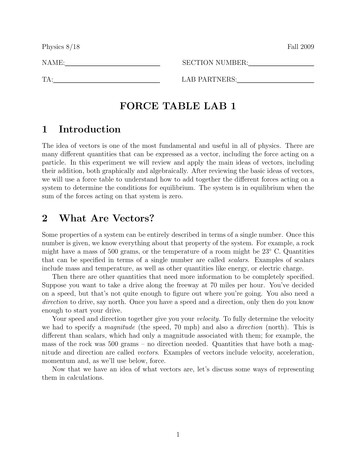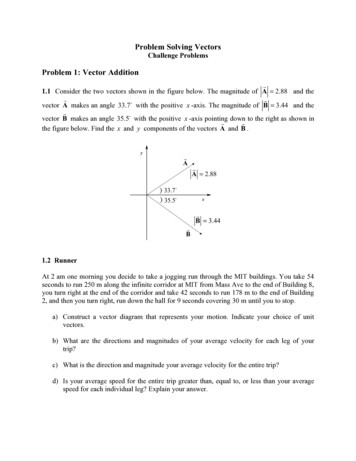
Transcription
pSilencer siRNA Expression Vectors(Cat #AM7209, AM7210)Instruction ManualI.Product Description and Background . . . . . . . . . . . . . . . . . . . . . . . . . . . . . . . . . . . . . . . . . . . . . . . . . 1A. siRNA and RNA InterferenceB. pSilencer siRNA Expression VectorsC. siRNA Template DesignD. Kit Components and Storage ConditionsE. Other Required MaterialF. Related Products Available from AmbionII.Planning and Preliminary Experiments . . . . . . . . . . . . . . . . . . . . . . . . . . . . . . . . . . . . . . . . . . . . . . . . 6A. siRNA Target Site SelectionB. Hairpin siRNA Template Oligonucleotide Design & OrderingIII.Using the pSilencer siRNA Expression Vector . . . . . . . . . . . . . . . . . . . . . . . . . . . . . . . . . . . . . . . . . . . 9A. Cloning Hairpin siRNA Inserts into the pSilencer VectorB. Transfecting pSilencer Vectors into Mammalian CellsIV.Troubleshooting. . . . . . . . . . . . . . . . . . . . . . . . . . . . . . . . . . . . . . . . . . . . . . . . . . . . . . . . . . . . . . . . . . . . 12A. Positive Control LigationB. Using the Positive and Negative ControlsC. Low E. coli Transformation EfficiencyD. Equal Numbers of E. coli Colonies from Minus- and Plus-insert Ligation TransformationsE. Poor Mammalian Cell Transfection EfficiencyV.Appendix . . . . . . . . . . . . . . . . . . . . . . . . . . . . . . . . . . . . . . . . . . . . . . . . . . . . . . . . . . . . . . . . . . . . . . . . . . 16A. ReferencesB. pSilencer siRNA Expression Vectors SpecificationsC. Quality Control
Manual 7209M Revision BRevision Date: November 2, 2006For research use only. Not for use in diagnostic procedures. By use of this product, you accept the terms andconditions of all applicable Limited Label Licenses. For statement(s) and/or disclaimer(s) applicable to thisproduct, see below.Literature Citation When describing a procedure for publication using this product, we would appreciate that you referto it as the pSilencer siRNA Expression Vectors.If a paper that cites one of Ambion’s products is published in a research journal, the author(s) may receive a free Ambion Tshirt by sending in the completed form at the back of this instruction manual, along with a copy of the paper.Warranty and Liability Ambion is committed to providing the highest quality reagents at competitive prices. Ambionwarrants that for the earlier of (i) one (1) year from the date of shipment or (ii) until the shelf life date, expiration date, “useby” date, “guaranty date”, or other end-of-recommended-use date stated on the product label or in product literature thataccompanies shipment of the product, Ambion's products meet or exceed the performance standards described in the product specification sheets if stored and used properly. No other warranties of any kind, expressed or implied, are provided byAmbion. WARRANTIES OF MERCHANTABILITY OR FITNESS FOR A PARTICULAR PURPOSE AREEXPRESSLY DISCLAIMED. AMBION'S LIABILITY SHALL NOT EXCEED THE PURCHASE PRICE OF THEPRODUCT. AMBION SHALL HAVE NO LIABILITY FOR INDIRECT, CONSEQUENTIAL, OR INCIDENTALDAMAGES ARISING FROM THE USE, RESULTS OF USE, OR INABILITY TO USE ITS PRODUCTS. See the fulllimited warranty statement that accompanies products for full terms, conditions and limitations of Ambion's limited product warranty, or contact Ambion for a copy.Patents and Licensing Notifications This product is covered by United States Patent Application No. 10/195,034,and PCT patent application No. US02/22010, owned by the University of Massachusetts. The purchase of this productconveys to the buyer the limited, non-exclusive, non-transferable right (without the right to resell, repackage, or furthersublicense) under these patent rights to perform the siRNA vector synthesis methods claimed in those patent applicationsfor research and development purposes solely in conjunction with this product. No other license is granted to the buyerwhether expressly, by implication, by estoppel or otherwise. In particular, the purchase of this product does not include norcarry any right or license to use, develop, or otherwise exploit this product commercially, and no rights are conveyed to thebuyer to use the product or components of the product for any other purposes, including without limitation, provision ofservices to a third party, generation of commercial databases, or clinical diagnostics. This product is sold pursuant to anexclusive license from the University of Massachusetts, and the University of Massachusetts reserves all other rights underthese patent rights. For information on purchasing a license to the patent rights for uses other than in conjunction with thisproduct or to use this product for purposes other than research, please contact the University of Massachusetts, Office ofCommercial Ventures and Intellectual Property, 365 Plantation Street, Suite 103, Worcester, Massachusetts 01655.This product is the subject of the following patents: U.S. Patent No. 6,573,099 and foreign counterparts co-owned by Benitec Australia Ltd. Not-for-profit and academic entities who purchase this product receive the non-transferable right to usethe product and its components in non-Commercial Purpose internal research.All commercial and for-profit purchasers using this product for a Commercial Purpose are required to execute a commercialresearch license with Benitec by contacting Benitec at www.licensing@benitec.com Entities wishing to use ddRNAi as atherapeutic agent or as a method to treat/prevent human disease also should contact Benitec at www.licensing@benitec.comCommercial Purpose means any activity by a party for tangible consideration and may include, but is not limited to, (i) useof the product in manufacturing; (ii) use of the product to provide services, information or data for a compensatory fee; (iii)use of the product for therapeutic, diagnostic or prophylactic purposes; (iv) use of the product in drug discovery or targetvalidation and/or (v) resale of the product or its components whether or not the product is resold for use in research.If purchaser is not willing to accept the limitations of this label license, seller is willing to accept the return of the productwith a full refund. For terms and additional information relating to a commercial research license, or for licensing for anyhuman therapeutic purpose, contact Benitec by email at www.licensing@benitec.comAmbion/AB Trademarks Applied Biosystems, AB (Design), and Applera are registered trademarks of Applera Corporation or its subsidiaries in the US and/or certain other countries. Ambion, The RNA Company, RNase Zap and Silencer areregistered trademarks; pSilencer and siPORT are trademarks of Ambion, Inc. in the U.S. and/or certain other countries.All other trademarks are the sole property of their respective owners. Copyright (2006) by Ambion, Inc., an Applied Biosystems Business. All Rights Reserved.
Product Description and BackgroundI.Product Description and BackgroundA. siRNA and RNA InterferenceSmall Interfering RNAs (siRNAs) are short, double-stranded RNA molecules that can target mRNAs with complementary sequence for degradation via a cellular process termed RNA interference (RNAi) (Elbashir2001). Researchers in many disciplines employ RNAi to analyze genefunction in mammalian cells. The siRNA used in early studies was typically prepared in vitro and transfected into cells. Later publications featureplasmids that express functional siRNA when transfected into mammalian cells (Sui 2002, Lee 2002, Paul 2002, Paddison 2002, Brummelkamp2002). Using siRNA expression vectors can reduce the expression of target genes for weeks or even months (Brummelkamp 2002), whereassiRNA prepared in vitro and delivered by transient transfection typicallyknocks down gene expression for 6–10 days (Byrom 2002).B. pSilencer siRNA Expression VectorsMammalian promoters forsiRNA expressionThe pSilencer vectors employ RNA polymerase III (pol III) promoterswhich generate large amounts of small RNA using relatively simple promoter and terminator sequences. Ambion’s pSilencer 2.0-U6 siRNAExpression vector features a human U6 RNA pol III promoter, andpSilencer 3.0-H1 contains the H1 RNA pol III promoter. These promoters are well characterized (Myslinski 2001, Kunkel 1989), and they provide high levels of constitutive expression across a variety of cell types. Theterminator consists of a short stretch of uridines (usually 3–4 nt); this iscompatible with the original siRNA design that terminates with a twouridine 3' overhang (Elbashir 2001).Based on comparisons of several different RNA pol III promoters, theactivities of the two promoters are likely to vary from cell type to celltype (Ilves 1996). The localization of expressed RNA is also likely tovary with cell type and with RNA pol III promoter (Ilves 1996). Tooptimize siRNA expression, we find it beneficial to clone hairpin siRNAs into both the pSilencer 2.0-U6 and pSilencer 3.0-H1 vectors andtransfect them into the cells being targeted for gene knockdown. Thepromoter that is more effective for the siRNA and cell type will providegreater levels of gene silencing.I.A. siRNA and RNA Interference1
pSilencer siRNA Expression VectorspSilencer plasmids aresupplied ligation-readyThe pSilencer siRNA Expression Vectors are linearized with bothBamH 1 and Hind III to facilitate directional cloning. They are purifiedto remove the digested insert so that it cannot re-ligate with the vector.This greatly increases the percentage of clones bearing the hairpinsiRNA-coding insert after ligation, reducing the time and effortrequired to screen clones. Both pSilencer 2.0-U6 and pSilencer 3.0-H1are linearized with the same restriction enzymes, so that a given hairpinsiRNA insert can be subcloned into either vector using the 5' overhangsleft by restriction enzyme digestion. A basic pSilencer vector map isshown in Figure 1 on page 2; more detailed sequence information aboutthe pSilencer vectors is available on Ambion’s website. Follow the linksat the following web 209Figure 1. pSilencer Vector Map(These maps show the vectors containing typical siRNA template inserts.)SspI (2948)(2930)(1)HindIII (400)siRNABamHI (462)AmpicillinU6 PromoterpSilencer 2.0-U63130 bp(2070)(2009)U6 Promoter: 462-795Ampicillin: 2071-2930ColE1 origin: 1124-2009EcoRI (795)(1124)ColE1 originSspI (2613)(2595)(1)EcoRI (397)H1 PromoterBamHI (496)siRNAHindIII (557)AmpicillinpSilencer 3.0-H12795 bp(790)H1 Promoter: 397-496Ampicillin: 1735-2595ColE1 origin: 790-16752I.B. pSilencer siRNA Expression Vectors(1735)(1675)ColE1 origin
Product Description and BackgroundC. siRNA Template DesignFigure 2. Hairpin siRNASense StrandUCA5‘- NNNNNNNNNNNNNNNNNNN U3‘- U UNNNNNNNNNNNNNNNNNNN AAntisense StrandAG AGHairpinStrategy for selection ofsiRNA target sitesLoopThe prototypical siRNA comprises two hybridized 21-mer RNA molecules with 19 complementary nucleotides and 3' terminal dinucleotideoverhangs. Expression vectors with dual promoters that express thetwo strands of the siRNA separately can be used (Lee 2002), however, amore efficient scheme is to express a single RNA that is a 19-mer hairpinwith a loop and 3' terminal uridine tract (Paddison 2002) (Figure 2).When expressed in mammalian cells, the short hairpin siRNA is apparently recognized by Dicer, the nuclease responsible for activating dsRNAsfor the RNAi pathway, and cleaved to form a functional siRNA (Brummelkamp 2002). For cloning into an siRNA expression vector, hairpinsiRNA inserts have the advantage that only a single pair of oligonucleotides and a single ligation are needed to generate plasmid for gene silencing studies. For each target gene, design complementary 55–60 meroligonucleotides with 5' single-stranded overhangs for ligation into thepSilencer vectors. The oligonucleotides should encode 19-mer hairpinsequences specific to the mRNA target, a loop sequence separating thetwo complementary domains, and a polythymidine tract to terminatetranscription (this is discussed in section II.B on page 7).The susceptibility of siRNA target sites to siRNA-mediated gene silencing appears to be the same for both in vitro prepared siRNAs and RNApol III-expressed siRNAs. Thus sequences that have been successfullytargeted with a chemically synthesized, in vitro transcribed, orPCR-generated siRNA should also be susceptible to down-regulationwith an siRNA expressed from a pSilencer vector. If an siRNA target sitehas not already been identified, then we recommend that several different siRNAs be tested per gene. Once an effective target site is identified,oligonucleotides encoding hairpin siRNAs can be synthesized andligated into pSilencer siRNA Expression Vectors. This significantlyreduces the time and effort required to develop an effective siRNA plasmid specific to a given gene.I.C. siRNA Template Design3
pSilencer siRNA Expression VectorsD. Kit Components and Storage ConditionsEach pSilencer siRNA Expression Vector includes 4 components: Linearized pSilencer siRNA Expression Vector ready for ligation Circular, negative control pSilencer vector that expresses a hairpinsiRNA with limited homology to any known sequences in thehuman, mouse, and rat genomes GAPDH-specific, hairpin siRNA insert that can be used as a positivecontrol for ligation 1X DNA Annealing Solution to prepare annealed DNA oligonucleotides for ligation into the pSilencer ilencer 2.0-U6–20 C10 µL––pSilencer 2.0-U6 Negative Control (0.5 µg/µL) –20 C––20 µLpSilencer 3.0-H120 µL–20 C––10 µLpSilencer 3.0-H1 Negative Control (0.5 µg/µL) –20 C10 µL10 µLGAPDH Control Insert (80 ng/µL)–20 C1 mL1 mL1X DNA Annealing Solution–20 CProperly stored kits are guaranteed for 6 months from the date of shipment.E.Other Required MaterialLigation and transformation Two complementary oligonucleotides targeting the gene of interestfor RNAi (design and ordering is discussed in section II starting onpage 6) DNA ligase, ligase reaction buffer, and competent E. coli cells areneeded to subclone the siRNA inserts. Ampicillin or carbenicillin containing plates and liquid media willalso be needed to propagate the plasmids.Plasmid purificationFor efficient transfection into mammalian cells it is crucial that preparations of pSilencer be very pure.Mammalian cell transfectionreagentsThe optimal mammalian cell transfection conditions including transfection agent and plasmid amount must be determined empirically.4I.D. Kit Components and Storage Conditions
Product Description and BackgroundF.Related Products Available from AmbionT4 DNA LigaseCat #AM2130, AM2132, AM2134siPORT XP-1DNA Transfection AgentCat #AM4506, AM4507KDalert GAPDH Assay KitCat #AM1639RNase-free Tubes & Tipssee our web or print catalogSilencer siRNA ConstructionKitCat #AM1620Silencer siRNAssee our web or print catalogwww.ambion.com/siRNAAntibodies for siRNA Researchsee our web or print catalogSilencer siRNA ControlsCat #AM4250–AM4639see our web or print catalogwww.ambion.com/siRNAT4 DNA Ligase (E.C. 6.5.1.1) catalyzes the formation of phosphodiesterbonds between adjacent 3' hydroxyl and 5' phosphate groups in double-stranded DNA. T4 DNA ligase will join both blunt-ended and cohesive-ended DNA and can also be used to repair nicks in duplex DNA.Includes 10X Ligase Reaction Buffer.siPORT XP-1 is an easy-to-use transfection reagent that efficiently deliversboth plasmid DNA and PCR products into a variety of mammalian celltypes. Comprised of a proprietary formulation of polyamines, siPORT XP-1exhibits low toxicity and can be used either in the presence or absence ofserum.The KDalert GAPDH Assay Kit is a rapid, convenient, fluorescence-basedmethod for measuring the enzymatic activity of glyceraldehyde-3-phosphatedehydrogenase (GAPDH) in cultured human, mouse, or rat cells. The KDalert GAPDH Assay Kit facilitates identification of optimal siRNA deliveryconditions by assessment of GAPDH expression and knockdown at the protein level and integrates seamlessly with the Silencer CellReady siRNATransfection Optimization Kit (Cat #AM86050) and Silencer GAPDH Control siRNAs (Cat #AM4605, 4624).Ambion’s RNase-free tubes and tips are available in most commonly usedsizes and styles. They are guaranteed RNase- and DNase-free. See our latestcatalog or our website (www.ambion.com) for specific information.The Silencer siRNA Construction Kit synthesizes siRNA by in vitro transcription, producing transfection-ready siRNA at a fraction of the cost ofchemical synthesis. The Silencer siRNA Construction Kit includes allreagents for transcription, hybridization, nuclease digestion, and clean up ofsiRNA (except gene specific oligonucleotides for template construction).Ambion’s Silencer Pre-designed siRNAs, Validated siRNAs, and siRNALibraries are designed with the most rigorously tested siRNA design algorithm in the industry. Silencer siRNAs are available for 100,000 human,mouse, and rat targets from our searchable online database. Because of theircarefully optimized design, Silencer siRNAs are very effective, and they areguaranteed to reduce target mRNA levels by 70% or more. Furthermore,their exceptional potency means that Silencer siRNAs effectively induceRNAi at very low concentrations, minimizing off-target effects.For select Silencer Control and Validated siRNAs, Ambion offers corresponding antibodies for protein detection. These antibodies are ideal for confirming mRNA knockdown results by analyzing concomitant protein levels.Silencer siRNA Controls are chemically synthesized siRNAs for genes commonly used as controls. Validated control siRNAs are available for genes suchas GAPDH, β-actin, cyclophilin, KIF11 (Eg5), GFP, and luciferase. ThesesiRNAs are ideal for developing and optimizing siRNA experiments and havebeen validated for use in human cells; many are also validated in mouse andrat cells.I.F. Related Products Available from Ambion5
pSilencer siRNA Expression VectorsII.Planning and Preliminary ExperimentsA. siRNA Target Site SelectionUsing siRNA for gene silencing is a rapidly evolving tool in molecularbiology; these instructions are based on both the current literature, andon empirical observations by scientists at Ambion. Because we are ableto modify information on our web site so quickly (compared to printeddocuments), you may want to check the “siRNA Design” page on ourweb site for the latest recommendations on siRNA target selection.http://www.ambion.com/techlib/misc/siRNA design.html1. Find 21 nt sequences inthe target mRNA thatbegin with an AAdinucleotideBeginning with the AUG start codon of your transcript, scan for AAdinucleotide sequences. Record each AA and the 3' adjacent19 nucleotides as potential siRNA target sites.2. Select 2–4 targetsequencesResearch at Ambion has found that typically more than half of randomly designed siRNAs provide at least a 50% reduction in targetmRNA levels and approximately 1 of 4 siRNAs provide a 75–95%reduction. Choose target sites from among the sequences identified instep 1 based on the following guidelines:This strategy for choosing siRNA target sites is based on the observationby Elbashir et al. (EMBO 2001) that siRNA with 3' overhanging UUdinucleotides are the most effective. This is compatible with using RNApol III to transcribe hairpin siRNAs because it terminates transcriptionat 4–6 nucleotide poly(T) tracts creating RNA molecules with a shortpoly(U) tail. Since a 4–6 nucleotide poly(T) tract acts as a termination signal forRNA pol III, avoid stretches of 4 T’s or A’s in the target sequence. Since some regions of mRNA may be either highly structured orbound by regulatory proteins, we generally select siRNA target sitesat different positions along the length of the gene sequence. We havenot seen any correlation between the position of target sites on themRNA and siRNA potency. Compare the potential target sites to the appropriate genome database (human, mouse, rat, etc.) and eliminate from consideration anytarget sequences with more than 16–17 contiguous base pairs ofhomology to other coding sequences. We suggest using BLAST,which can be found on the NCBI server at:www.ncbi.nlm.nih.gov/BLAST.6II.A. siRNA Target Site Selection
Planning and Preliminary Experiments Ambion researchers find that siRNAs with 30–50% G/C content aremore active than those with a higher G/C content.3. Negative ControlsA complete siRNA experiment should include a nontargeting negativecontrol siRNA with the same nucleotide composition as your siRNAbut which lacks significant sequence homology to the genome. Todesign a negative control siRNA, scramble the nucleotide sequence ofthe gene-specific siRNA and conduct a search to make sure it lackshomology to any other gene.B. Hairpin siRNA Template Oligonucleotide Design & OrderingAmbion’s web-basedresourcesWeb-based target sequence converterThe easiest way to design hairpin siRNA template oligonucleotides is toenter your siRNA target sequence into the web-based insert design toolat the following address:www.ambion.com/techlib/misc/psilencer converter.htmlCurrent, detailed hairpin siRNA template design informationAmbion Technical Bulletin #506 includes an in depth discussion ofinformation gleaned from the current literature and from experimentsperformed at Ambion regarding hairpin siRNA stem length and loopdesign, as well as our most current recommendations on hairpin siRNAtemplate design. Obtain it from our web site at the following address, orrequest it from our Technical Services Department (contact information is on the back cover of this booklet).http://www.ambion.com/techlib/tb/tb 506.htmlOligonucleotide designTwo complementary oligonucleotides must be synthesized, annealed,and ligated into the pSilencer vector for each siRNA target site. Figure 3on page 8 shows schematically how to convert siRNA target sites intooligonucleotide sequences for use in the pSilencer vectors.The oligonucleotides encode a hairpin structure with a 19-mer stemderived from the mRNA target site. The loop of the hairpin siRNA islocated close to the center of the oligonucleotides; a variety of loopsequences have been successfully used by researchers (Sui 2002, Lee2002, Paddsion 2002, Brummelkamp 2002, Paul 2002), and we haveobserved no particular benefit in using one or another. The loopsequence shown in Figure 3, 5'-UUCAAGAGA-3', is one possiblesequence.II.B. Hairpin siRNA Template Oligonucleotide Design & Ordering7
pSilencer siRNA Expression VectorsNear the end of the hairpin siRNA template is a 5–6 nucleotide poly(T)tract recognized as a termination signal by RNA pol III that will terminate siRNA synthesis. The function of the 5'-GGAA-3' just downstreamof the RNA pol III terminator site is not fully understood, but we recommend that it be included for optimal gene silencing.The 5' ends of the two oligonucleotides are noncomplementary andform the BamH I and Hind III restriction site overhangs that facilitateefficient directional cloning into the pSilencer vectors. Just downstreamof the BamH I site, it is advantageous to have a G or an A residue becauseRNA pol III prefers to initiate transcription with a purine. For siRNAtargets with a C or a U residue at position 1 (the first nucleotide after theAA in the RNA target sequence), add an additional G (shown with anasterisk in Figure 3) to facilitate transcription of the siRNA by RNApol III.Synthesis of hairpin siRNAtemplate oligonucleotidesfor ligation into pSilencervectorsOrder a 25–100 nM scale synthesis of each oligonucleotide. Typicallywe use economical, desalted-only DNA oligonucleotides in this procedure. It is important, however, that the oligonucleotides are mostlyfull-length. Choose a supplier that is reliable in terms of oligonucleotidesequence, length, and purity. Contact Ambion Technical ServicesDepartment for an oligonucleotide supplier recommendation if youneed one.Figure 3. Hairpin siRNA Template DesignExample Target Sequence (AA plus 19 nt)5'AA GTCAGGCTATCGCGTATCG3'NOTEThe easiest way to designhairpin siRNA template oligonucleotides is to enteryour siRNA target sequenceinto our web-based targetsequence converter.Annealed Hairpin siRNA Template Insert (order these 2 oligonucleotides)RNA pol IIISense StrandLoopAntisense Strand TerminatorHin d III5'– GATCC GTCAGGCTATCGCGTATCG TTCAAGAGA CGATACGCGATAGCCTGAC TTTTTTGGAAA –3'3'– G CAGTCCGATAGCGCATAGC AAGTTCTCT GCTATGCGCTATCGGACTG AAAAAACCTTTTCGA –5'Bam H I*GCHairpin siRNA Structuresense sequence5'– GUCAGGCUAUCGCGUAUCG U3'–UUUUCAGUCCGAUAGCGCAUAGC Aantisense sequence*8UCGAAGAInclude an additional GC base pair at this position only if the downstream base on the top strand (the 1 position of thesiRNA) is a T or a C; if the 1 position is a G or an A, as it is in this example sequence, do not include it. The purpose ofthis additional base pair is to provide a G or an A residue as the first nucleotide of the siRNA transcript because RNApol III prefers to initiate transcription with a purine, thus it helps to facilitate efficient transcription. Note, this additionalnucleotide will not be complementary to either the target mRNA or the antisense strand of the hairpin siRNA. This extranucleotide in the sense strand appears to have no effect on the activity of the hairpin siRNA.II.B. Hairpin siRNA Template Oligonucleotide Design & Ordering
Using the pSilencer siRNA Expression VectorIII.Using the pSilencer siRNA Expression VectorA. Cloning Hairpin siRNA Inserts into the pSilencer Vector1. Prepare a 1 µg/µLsolution of eacholigonucleotidea. Dissolve the hairpin siRNA templateapproximately 100 µL of nuclease-free water.oligonucleotidesinb. Dilute 1 µL of each oligonucleotide 1:100 to 1:1000 in TE (10 mMTris, 1 mM EDTA) and determine the absorbance at 260 nm.Calculate the concentration (in µg/mL) of the hairpin siRNAoligonucleotides by multiplying the A260 by the dilution factor andthen by the average extinction coefficient for DNA oligonucleotides( 33 µg/mL).c. Dilute the oligonucleotides to approximately 1 µg/µL in TE.2. Anneal the hairpin siRNAtemplateoligonucleotidesa. Assemble the 50 µL annealing mixture as follows:AmountComponent2 µLsense siRNA template oligonucleotide2 µLantisense siRNA template oligonucleotide46 µL1X DNA Annealing Solutionb. Heat the mixture to 90 C for 3 min, then place in a 37 C incubator,and incubate for 1 hr.c. The annealed hairpin siRNA template insert can either be ligated intoa pSilencer vector immediately or stored at –20 C for future ligation.3. Ligate annealed siRNAtemplate insert into thepSilencer vectora. Dilute 5 µL of the annealed hairpin siRNA template insert with45 µL nuclease-free water for a final concentration of 8 ng/µL.b. Set up two 10 µL ligation reactions; a plus-insert ligation, and theminus-insert negative control. To each tube, add the followingreagents:Plus-insert Minus-insert Component1 µL––diluted annealed siRNA insert (from step 3.a)––1 µL1X DNA Annealing Solution6 µL6 µLNuclease-free Water1 µL1 µL10X T4 DNA Ligase Buffer1 µL1 µLpSilencer vector1 µL1 µLT4 DNA ligase (5 U/µL)III.A. Cloning Hairpin siRNA Inserts into the pSilencer Vector9
pSilencer siRNA Expression Vectorsc. Using Ambion’s T4 DNA ligase (Cat #AM2134), incubate for1–3 hr at room temp (the reactions can be incubated overnight at16 C if very high ligation efficiency is required).The recommended incubation time and temperature for ligationreactions varies widely among different sources of T4 DNA ligase.Follow the recommendation provided by the manufacturer of yourDNA ligase, if using a source other than Ambion.4. Transform E. coli with theligation productsa. Transform an aliquot of cells with the plus-insert ligation products,and transform a second aliquot with the minus-insert ligationproducts. Use an appropriate amount of ligation product accordingto how the competent cells were prepared and the transformationmethod.(For chemically competent cells, we routinely transform with 3 µL ofthe ligation reaction.)b. Plate the transformed cells on LB plates containing 50–200 µg/mLampicillin or carbenicillin and grow overnight at 37 C. Generally it isa good idea to plate 2–3 different amounts of transformed cells so thatat least one of the plates will have distinct colonies.Always include a nontransformed competent cell control: this negative control is a culture of your competent cells plated at the samedensity as your transformed cells.c. Examine each plate and evaluate the number of colonies promptlyafter overnight growth at 37 C (or store the plates at 4 C until theyare evaluated).5. Expected resultsNon-transformed control culture:The nontransformed control culture should yield no colonies (indicating that the antibiotic in the culture medium is effective at inhibitingthe growth of E. coli that do not contain the pSilencer vector).Plus- and minus-insert ligation transformationsIdentify the dilution of plus- and minus-insert ligation transformationsthat yield well-spaced (countable) colonies, and count the colonies onthose plates. The minus-insert ligation will probably result in someampicillin resistant colonies (background), but the plus-insert ligationshould yield 2–10 fold more colonies than the minus-insert ligation.(Remember to take the dilution into account when calculating the proportion of background colonies.)10III.A. Cloning Hairpin siRNA Inserts into the pSilencer Vector
Using the pSilencer siRNA Expression Vector6. Identify clones with thesiRNA template insertPick clones, isolate plasmid DNA, and sequence with the primersshown below to verify that the clone contains the insert, and that it isthe desired sequence. A link to the entire pSilencer sequence is providedon Ambion’s web site, ilencer 2.0-U65'-AGGCGATTAAGTTGGGTA-3'pSilencer GGC-3'(M13 forward (–40) sequencing primer)7. Purify pSilencer plasmidfor transfection5'-TAATACGACTCACTA
knocks down gene expression for 6-10 days (Byrom 2002). B. p Silencer siRNA Expression Vectors Mammalian promoters for siRNA expression The p Silencer vectors employ RNA polymerase III (pol III) promoters which generate large amounts of small RNA using relatively simple pro-moter and terminator sequences. Ambion's p Silencer 2.0-U6 siRNA
